5G and The 4th Industrial Revolution
5G is the next generation of mobile internet connectivity. Experts say 5G connectivity not only means outstanding network reliability but also a major change of how we live and work – the 4th Industrial Revolution.
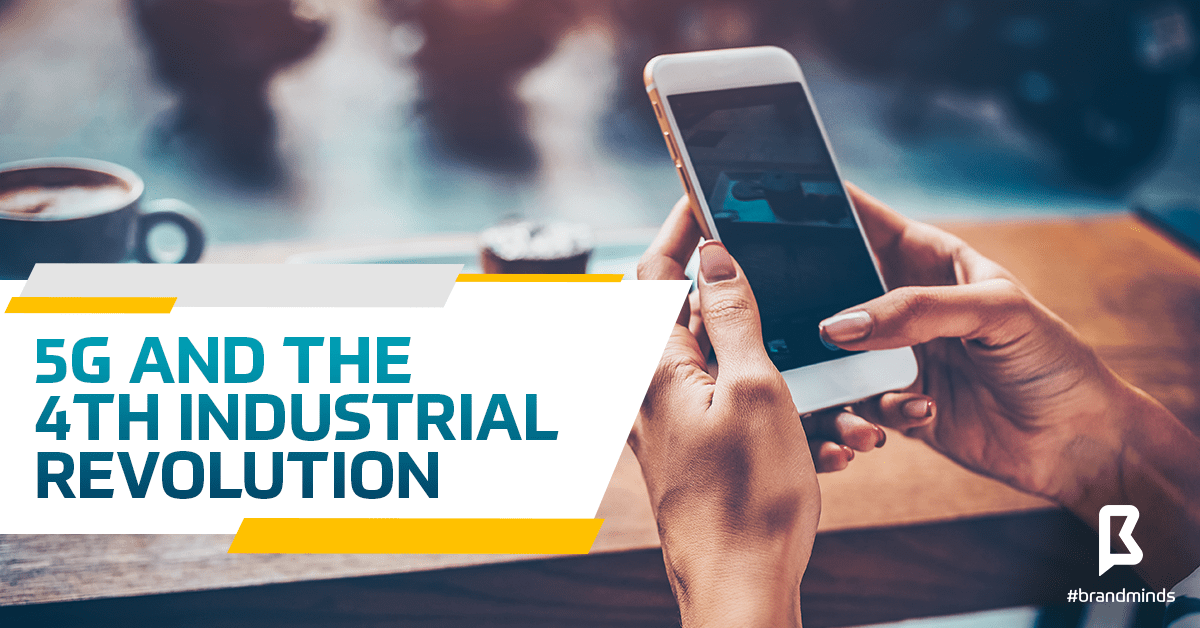
The connectivity benefits of 5G will make businesses more efficient and give consumers access to more information faster than ever before. Super-connected autonomous cars, smart communities, industrial IoT, immersive education—they all will rely on 5G.
Verizon
How is 5G superior to our current 4G connectivity?
Here are the most important features and benefits of 5G:
- Increased Speed: 5G is approximately 20 times faster than 4G;
- Increased Download speed: 5G offers a minimum peak download of 20 Gb/s while 4G pokes along at only 1 Gb/s;
- Lower Latency: 5G provides below 1-ms latency compared with 30 – 70 ms for 4G.
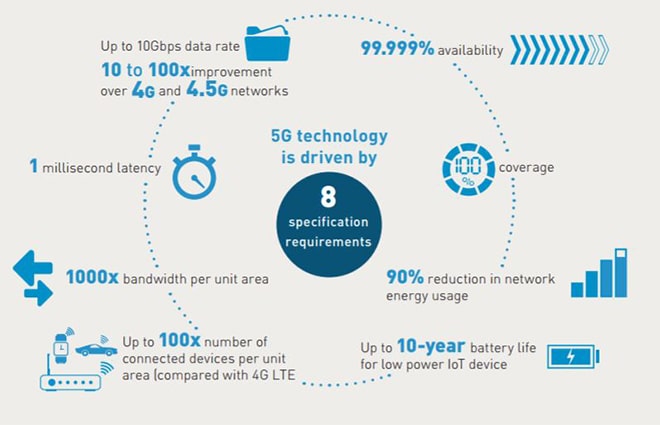
image source: gemalto.com
Superior speed and increased download speed mean IoT will finally be made possible and smart cities will emerge.
Lower latency makes 5G-enabled technology highly suitable for critical applications that require rapid responsiveness, such as remote vehicle control.
5G isn’t just another iteration of wireless innovation.
Ronan Dunne, Executive Vice President and Group President, Verizon Wireless
Is 5G setting the world on the path to the 4th Industrial Revolution?
5G represents a massive upscale of network technology. It will provide data transfer rates many times faster than a blink of an eye, high bandwidth and greater opportunities for connectivity and reliability.
But according to Ronan Dunne, 5G doesn’t upgrade incrementally, but exponentially which supports the advent of the 4th industrial revolution.
5G will improve many industries and make new developments possible like the following:
- Social VR;
- AR in sports;
- Smart cities applications;
- Connected cars.
Social VR is The Next VR development
No matter the latest tech developments in regards to medium or tools, what we humans look for is interaction with others. This is the case for VR also. According to Verizon, 78% of survey respondents who have used VR said they wanted to interact with other people in the virtual environment. That’s why social VR is a new development in VR in recent years.
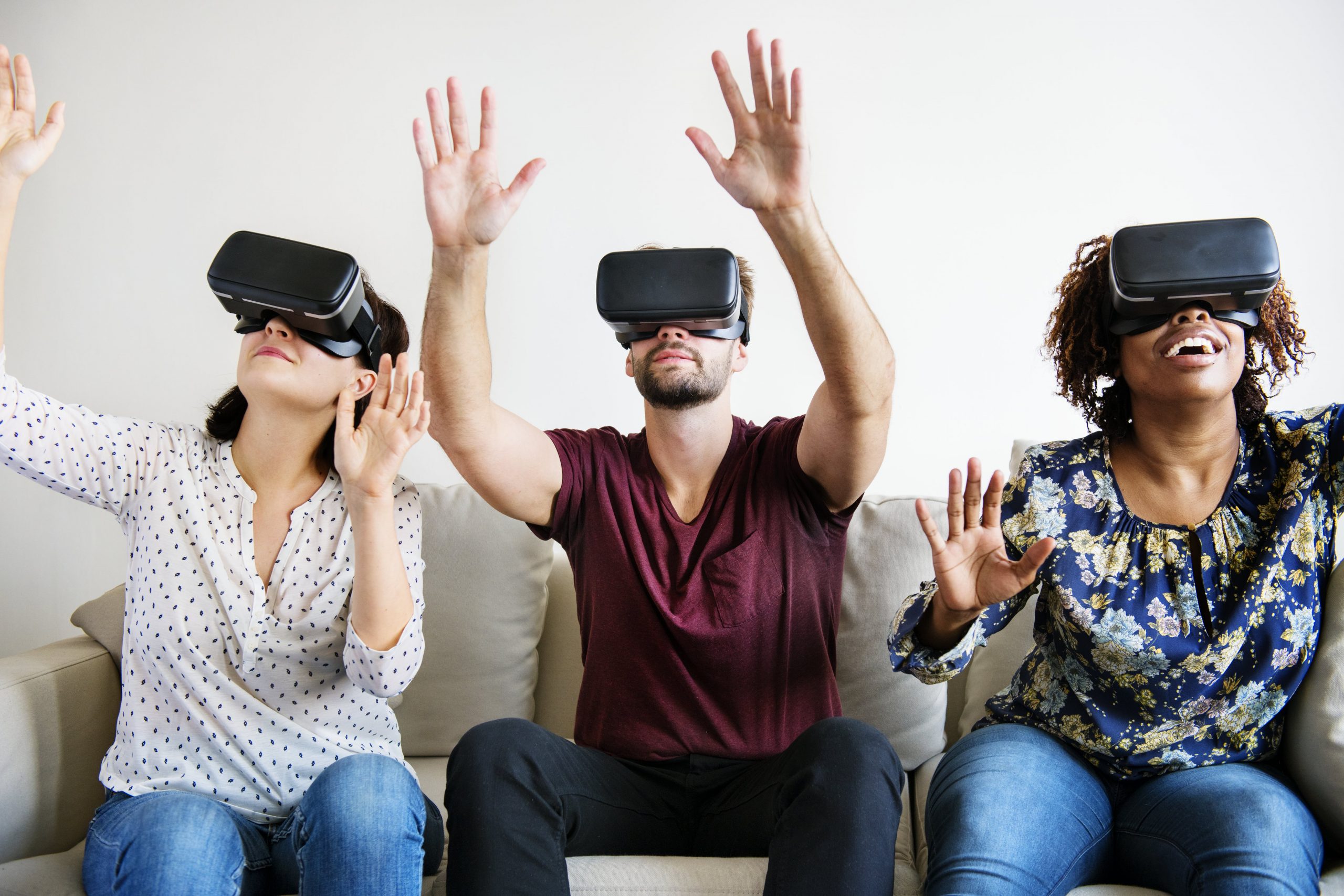
Social VR is when users create or visit virtual environments in the company of friends, hang out in clubs, get together at parties or at the movies. 5G will help make the VR experience feel more and more real; it will usher in a world where VR becomes our primary communication system.
AR for sports – Making sports experiences more fun for younger audiences
The average fan’s age is over 40 and major sports leagues are looking for ways to attract, engage and retain younger audiences. 5G promises to take sports experiences to a whole new level and make it more exciting for fans in their twenties or younger.

The goal of all major sports leagues is to have people buy tickets and come to the stadiums. 5G-enabled AR might just be the solution.
From AR games during timeouts, participation in game quizzes and polls to AR portals which will allow fans to virtually walk into the locker rooms, on the field or into a player interview.
5G will also prove useful for improving how the audience is experiencing real-time sports matches:
The high bandwidth of 5G will also allow fans to upload their view of the game so they can switch between feeds from the cameras in the stadium to feeds from the fans point of view.
Verizon
It’s all about providing a personalized experience of the game and a personalized way to watch the game.
Smart cities – Smart society
5G has the power to lead our cities into the future. In this future, our cities will develop economically; they will be environmentally sustainable and will rise on the foundations of competitiveness, economic progress and security, social cohesion and innovation.

These smart cities will be seeds from which the smart society will bloom. A society that improves the quality of life for residents, businesses and visitors altogether.
5G could impact almost every aspect of city operations and service delivery: power and water grids, trash collection, transit, public health and education, pollution and disaster management.
Smart cities benefits:
- Smart traffic management;
- Smart grids;
- Smart homes;
- Smart healthcare and security;
- Smart transportation.
Connected cars are already here
What is a connected car?
A connected car is a car which is equipped with internet access and a wireless local area network.
Car connectivity has developed in two directions: vehicle-to-vehicle (V2V) connectivity and vehicle-to-everything (V2X) connectivity.

V2V means vehicles communicating with others on the roads so drivers are made aware of the location of the other participants within traffic, their destination and speed. The benefits of this type of connectivity are many: advanced warning of traffic build-up, opportunities for drivers to adapt their driving etc. All benefits converge to a safer traffic environment and faster journey.
V2X means everything on the roads is connected: vehicles are connected with each other but also with traffic lights, the roads themselves, lampposts etc. Everything is fitted with sensors which will collect data on everything: the traffic, the condition of the roads, weather, air quality, parking spaces, etc. The collected data can be used to: automatically change the timing of traffic lights to speed up or slow down in order to avoid or reduce congestion, identify roads in need of repair etc.
[bctt tweet=”To make the 4th Industrial Revolution possible, 4G is simply not enough, but 5G has what it takes.” username=”brand_minds”]
Join the Conversation
We’d love to hear what you have to say.
Get in touch with us on Facebook Group and Twitter.
sources:
verizon.com/about/our-company/5g/what-5g
verizon.com/about/our-company/fourth-industrial-revolution/social-vr-new-way-form-relationships
verizon.com/about/our-company/fourth-industrial-revolution/5g-changing-future-sports
verizon.com/about/our-company/fourth-industrial-revolution/powering-fourth-industrial-revolution-5g
5g.co.uk/guides/5g-and-the-connected-car/
Internet of Things and Marketing – 5 Predictions
Smart products use the Internet of Things (IoT) technology. It is changing the world.
But what does that translate to in the marketing world?
What can be expected in the years to come?
How will branding and marketing strategies have to change to capture this new emerging market?
Keep reading to discover 5 predictions regarding the way the Internet of Things (IoT) will change and improve marketing.
What is a smart product?
Smart devices have the ability to connect to the internet. This also enables a smart product to connect to another device. It makes use of IoT technology to establish connections to the internet and other products.
Smart products help to create new ways of automation. You can track, monitor, and control a smart product with another smart device.
What is IoT?
The Internet of Things is the giant network on which smart devices share information.
IoT data is stored in cloud technology and guarded by companies like manufacturers, marketers and other online service providers.
5 Predictions for IoT and Marketing
IoT technology is shaking things up. It’s changing the very face of many industries.
From manufacturing to healthcare, new depths of information are available. It is disrupting business as usual.
1. New Digital Devices Will Be Created
A need has caused the birth of many an invention. Smart devices have many more applications available. But, these devices will cause new needs to arise. Look at the rate at which portable and rechargeable power banks have spread across the world. People want on-demand recharging for their devices. The need for electricity in remote places has birthed an invention. Just so will IoT and its needs birth new inventions.
2. IoT Data Will Change Contextual Marketing
Millions of smart devices are already in operation all over the world. Big data is an understatement when it comes to harnessing worldwide IoT data. Users and customers will be tracked over the various products they own and use.
Marketers are able to pinpoint certain behaviours and preferences of customers. Marketing campaigns will be much more focused to try and increase their turnover rate. It may very well increase customer engagement due to new access to information previously unavailable.
3. IoT Data Will Be the Modern Day Gold Rush
IoT data and its uses will enjoy very high demand. And a higher demand always drives a higher price. IoT data will be expensive.
Companies from every imaginable industry will look for more comprehensive information. Information regarding their productivity, customers’ needs, industry trends, and other forecasting and budgeting related information. IoT data will supply the answers that will help companies to enhance productivity, sharpen execution, and retain customers.
4. Marketing Agency Roles Will Evolve
Advertising agencies have some of the smartest and sharpest brains around. People who can somehow connect the dots in seeming madness. The creativity of these agencies has captured the imaginations of the public through carefully crafted campaigns for its customers. They create and keep a following that leads to higher sales and revenues.
But, IoT data brings a new role into play. Agencies will also have to look into the data analytics and presentation of IoT data. IoT information about customers and their behaviours will change the marketing game. Agencies need to know how to gain the right information and also how to apply it. This type of information will lead to better results for its customers.
5. More Timely and Better Personalized Marketing
Online marketing can become overbearing and irritating to internet users. Much worse, it could be irrelevant. Irrelevant marketing is about as effective as a vacuum cleaner in a desert. It does its job but to no real effect.
IoT data will help marketers to create personalized and tailor-made campaigns for individual customers. It can even track specific actions and behaviours of customers to enhance customer engagement and turnover. That’s because data-driven relationships happen in the following order.
Data-Driven Relationships Process:
- More connected devices;
- Leads to more information;
- Leads to smarter data;
- Leads to relevant campaigns;
- Leads to increased customer engagement.
Marketers will be able to recognize where customers are in their lifecycle stage. The marketer will be able to guide customers to specific solutions that are relevant.
5 Ways Marketers Will Use IoT
So how will marketers then use this new type of information?
Here are a few ways that will change the marketing game.
1. Analyse Customer Buying Habits Across Platforms
Marketers will for instance track and monitor the devices that are used by a customer. They will notice certain habits on different devices. They will apply the relevant campaigns to the specific devices owned by a user.
2. Harness Information Previously Unavailable
Every smart device that connects to the internet will supply information. Users’ habits can be tracked in every room of their homes. Smart refrigerators will even track customer behaviour.
3. More Precise Information About Customer Lifecycle Stages
The customer’s lifecycle can be pinpointed with greater success. Marketers will understand the customers’ needs better. This will help to guide customers towards a sale much faster.
4. Enhance Customer Relations and Resolve Issues
Smart technology has narrowed the gap between the customer and the product or service provider. Customer grievances will be resolved much faster. It will even help facilitate something as tedious as product recalls with a customer specific approach. The marketing expenses will be kept low by only contacting customers with affected products.
5. Better and More Specific Marketing
The team from SafeAtLast says that IoT is changing the marketing game. Use it to your advantage and gain the success that comes with it.
Join the Conversation
We’d love to hear what you have to say.
Get in touch with us on Facebook Group and Twitter.
Worldwide technology trends in 2017
The technology is advancing nowadays even faster than the speed of light. Its advances and upgrades can seem overwhelming, thankfully though we have the specialists to help us understand where we are heading and how to handle it. The Deloitte’s 2017 report outlines how companies presently must sift through the promotional noise and hyperbole surrounding emerging technologies to find those solutions offering real potential. To realize that potential, they should become ‘kinetic’ organizations—companies with the dexterity and vision required to thrive amid ongoing technology-fueled disruption.
While the report identifies key trends that will likely revolutionize enterprise technology in the next 18-24 months, the exponentials chapter looks even farther into the future, describing four key areas that blend science and applied technologies.
The 2017 trends identified by Deloitte, digitaltrends.com, Forbes and Gartner are as follows:
IT unbounded—The boundaries surrounding IT are fading as technology becomes integral to almost every business function and relationship.
IoT and Smart Home Tech
A multitude of wireless technologies now exist to serve your smart home needs — Zigbee, Z-Wave, Bluetooth, Wi-Fi, and more. And there’s more smart home platforms to consider than ever before too — Wink, SmartThings, Iris by Lowe’s, even systems from security providers like ADT and big brands like Comcast. While centralization in theory should make things easier, it’s made it worse.
The AI world will have a head-on collision with the Internet of Things in 2017, too, Gartner predicts. IoT is where everyday items get chips or sensors, and apps, and join the internet — from your car to your toothbrush. It makes total sense that the apps that control IoT devices will also make use of machine learning.
In 2017, watch for devices to start to communicate and help each other make decisions. “As intelligent things, such as drones, autonomous vehicles and smart appliances, permeate the environment, Gartner anticipates a shift from stand-alone intelligent things to a collaborative intelligent things model,” Gartner says. Gartner estimates that six billion connected “things” will be actively requesting support from AI platforms by 2018.
The total IoT market is estimated to grow from $157.05 billion in 2016 to $661.74 billion by 2021, predicts Markets and Markets.
Artificial Intelligence and Automation
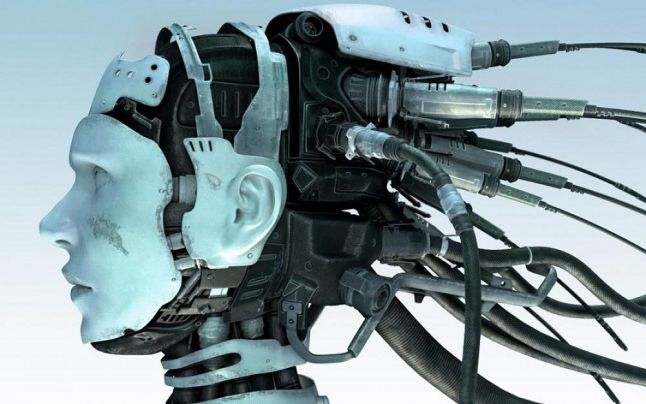
AI and chatbots that understand context a whole lot better than ever before. More and more jobs will also be automated, we’ll also see smart devices gain from increased automation, learning your patterns and preferences without you needing to tell them and making better and more accurate suggestions and recommendations.
Research firm Markets and Markets estimates that the AI market will grow from $420 million in 2014 to $5.05 billion by 2020.
Artificial Reality and Virtual Reality
According to Gartner, virtual reality (VR) and augmented reality (AR) transform the way individuals interact with each other and with software systems creating an immersive environment. For example, VR can be used for training scenarios and remote experiences. AR, which enables a blending of the real and virtual worlds, means businesses can overlay graphics onto real-world objects, such as hidden wires on the image of a wall. Immersive experiences with AR and VR are reaching tipping points in terms of price and capability but will not replace other interface models. Over time AR and VR expand beyond visual immersion to include all human senses. Enterprises should look for targeted applications of VR and AR through 2020.
As forbes.com points out we’ve already seen some major steps forward for augmented reality (AR) and virtual reality (VR) technology in 2016. Oculus Rift was released, to positive reception, and thousands of VR apps and games followed. We also saw Pokémon Go, an AR game, explode with over 100 million downloads. The market is ready for AR and VR, and we’ve already got some early-stage devices and tech for these applications, but 2017 it’s going to be the year we see things really take off. Once they do, you’ll need to be ready for AR and VR versions of practically everything—and ample marketing opportunities to follow.
“Look for navigation services to get even more specific — maps in a store’s app, for example, to direct you to a specific aisle to find exactly what you’re looking for. So called “augmented reality,” where virtual objects and information are displayed on top of the physical world, will make its way to our phones. Search engines are already expanding on image search, allowing you to point your camera at something and search for information based on what the lens takes in,” said Ed Oswald for digitaltrends.com.
IDC predicts that worldwide revenues for the augmented reality and virtual reality (AR/VR) market will grow from $5.2 billion in 2016 to more than $162 billion in 2020.
Advances in computer vision and pattern recognition allow companies to unlock insights from unstructured data that until now, have been lost in the dark.
Machine intelligence is helping companies make better decisions, embed complex analytics into customer and employee interactions, and—with adoption of bots and robotic process automation—automate increasingly difficult tasks.
“Throughout 2017, I expect to see machine learning updates emerge across the board, entering almost any type of consumer application you can think of, from offering better recommended products based on prior purchase history to gradually improving the user experience of an analytics app. It won’t be long before machine learning becomes a kind of “new normal,” with people expecting this type of artificial intelligence as a component of every form of technology,” predicts Jayson DeMers for Forbes.
Mixed reality (Physical-Digital Integrations)
Companies are exploring more immersive and engaging ways to combine the physical world and digital systems, creating a new, mixed reality that’s more natural, intuitive and intelligent.
Mobile devices have been slowly adding technology into our daily lives. It’s rare to see anyone without a smartphone at any given time, giving us access to practically infinite information in the real-world. We already have things like site-to-store purchasing, enabling online customers to buy and pick up products in a physical retail location, but the next level will be even further integrations between physical and digital realities. Online brands like Amazon will start having more physical products, like Dash Buttons, and physical brands like Walmart will start having more digital features, like store maps and product trials.
Open standards, cloud-first designs and loosely coupled architectures are the norm in start-ups. Now, large enterprises have similar ambitions.
Traditional business products are being reimagined as services as organizations modernize core systems and the technology stack.
Digital Twin
According to Gartner, within three to five years, billions of things will be represented by digital twins, a dynamic software model of a physical thing or system. Using physics data on how the components of a thing operate and respond to the environment as well as data provided by sensors in the physical world, a digital twin can be used to analyze and simulate real world conditions, responds to changes, improve operations and add value. Digital twins function as proxies for the combination of skilled individuals (e.g., technicians) and traditional monitoring devices and controls (e.g., pressure gauges). Their proliferation will require a cultural change, as those who understand the maintenance of real-world things collaborate with data scientists and IT professionals. Digital twins of physical assets combined with digital representations of facilities and environments as well as people, businesses and processes will enable an increasingly detailed digital representation of the real world for simulation, analysis and control.
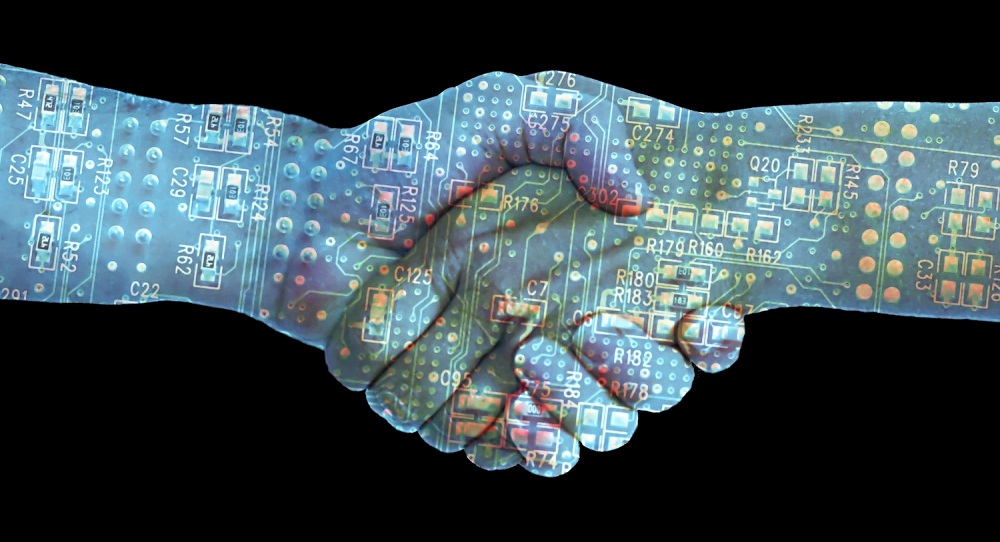
source: Blockchain Technologies
Blockchain, a way of distributing a database across many far-flung computers, is emerging as the mainstay for digital identities in the emerging trust economy.
Exponentials watch list – Advances in disruption forces like synthetic biology, energy storage, quantum computing, and nanotech could exponentially transform the way we do business. Remember the big Bitcoin phenom of 2015? It turns out that the coins themselves could be far less valuable than the underlying technology, called blockchain, that created them.
Consortiums have sprouted up to create new blockchain apps for the financial industry, for health care, and so on.
Market Reports Hub believes the global blockchain technology market will grow from $210.2 million in 2016 to $2.3 billion by 2021.
Advances in disruption forces like synthetic biology, energy storage, quantum computing, and nanotech could exponentially transform the way we do business.
Humanized Big Data (visual, empathetic, qualitative)
Big data has been a big topic for the past five years or so, when it started making headlines as a buzzword. According to Forbes, the idea is that mass quantities of gathered data—which we now have access to—can help us in everything from planning better medical treatments to executing better marketing campaigns. But big data’s greatest strength—its quantitative, numerical foundation—is also a weakness. In 2017, I expect we’ll see advancements to humanize big data, seeking more empathetic and qualitative bits of data and projecting it in a more visualized, accessible way.
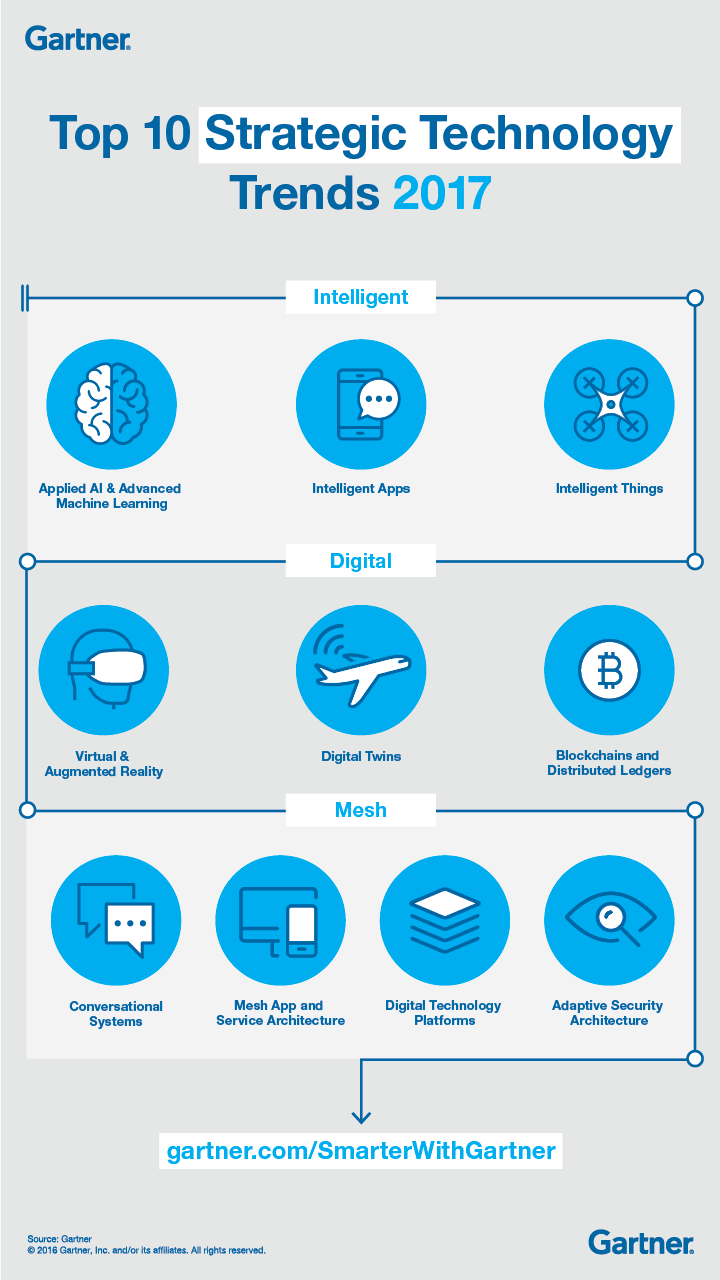
Adaptive Security Architecture
“The evolution of the intelligent digital mesh and digital technology platforms and application architectures means that security has to become fluid and adaptive. Security in the IoT environment is particularly challenging. Security teams need to work with application, solution and enterprise architects to consider security early in the design of applications or IoT solutions. Multilayered security and use of user and entity behavior analytics will become a requirement for virtually every enterprise,” points out Gartner.
Top Marketing Techniques in 2017
Smart Insights recently started a research asking its readers to give their opinion on the most important trends in 2017, asking them to choose the most important marketing activity that they think will give their business the biggest incremental uplift in leads and sales in 2017. After receiving 2,352 responses from marketers around the world, the results were:
- Big Data (including market and customer insight and predictive analytics)
- Content marketing Communities (Branded niche or vertical communities)
- Conversion rate optimisation (CRO)/ improving website experiences
- Display(Banners on publishers, ad networks social media including retargeting and programmatic)
- Internet of Things (IoT) marketing applications
- Marketing Automation(incl CRM, behavioural Email marketing and web personalisation)
- Mobile marketing (Mobile advertising, site development and apps)
- Paid search marketing, e.g. Google AdWords Pay Per Click
- Online PR (including influencer outreach)
- Partnerships (including affiliate and co-marketing
- Search Engine Optimisation (SEO or organic search)
- Social media marketing (including Social CRM and Social Customer Care)
- Wearables (e.g. Apple Watch, activity trackers, augmented reality)
More information on the report can be read here.

You can find out more here.
